Comprehensive Essay on Laboratory Management and Leadership
VerifiedAdded on 2020/06/04
|8
|2526
|161
Essay
AI Summary
This essay delves into the multifaceted aspects of laboratory management and leadership within the healthcare sector. It begins by defining leadership and laboratory management, highlighting the importance of effective strategies to achieve organizational goals, specifically focusing on the provision of accurate and timely clinical results. The essay then explores various management styles, including autocratic, democratic, and laissez-faire, and how they influence organizational culture. A significant portion of the essay is dedicated to the structure of laboratory management, emphasizing the roles and responsibilities of key personnel such as the director, quality assurance head, and technical supervisors. It also examines the impact of organizational culture on employee performance and service delivery. Furthermore, the essay discusses service delivery systems, clinical governance, and the importance of ethical leadership and the application of different leadership styles to enhance service quality. Finally, it emphasizes the role of business systems, user satisfaction, and continuous improvement in maintaining high standards of clinical care and operational efficiency. The essay concludes by reiterating the critical role of effective leadership in ensuring the successful management of laboratory operations.
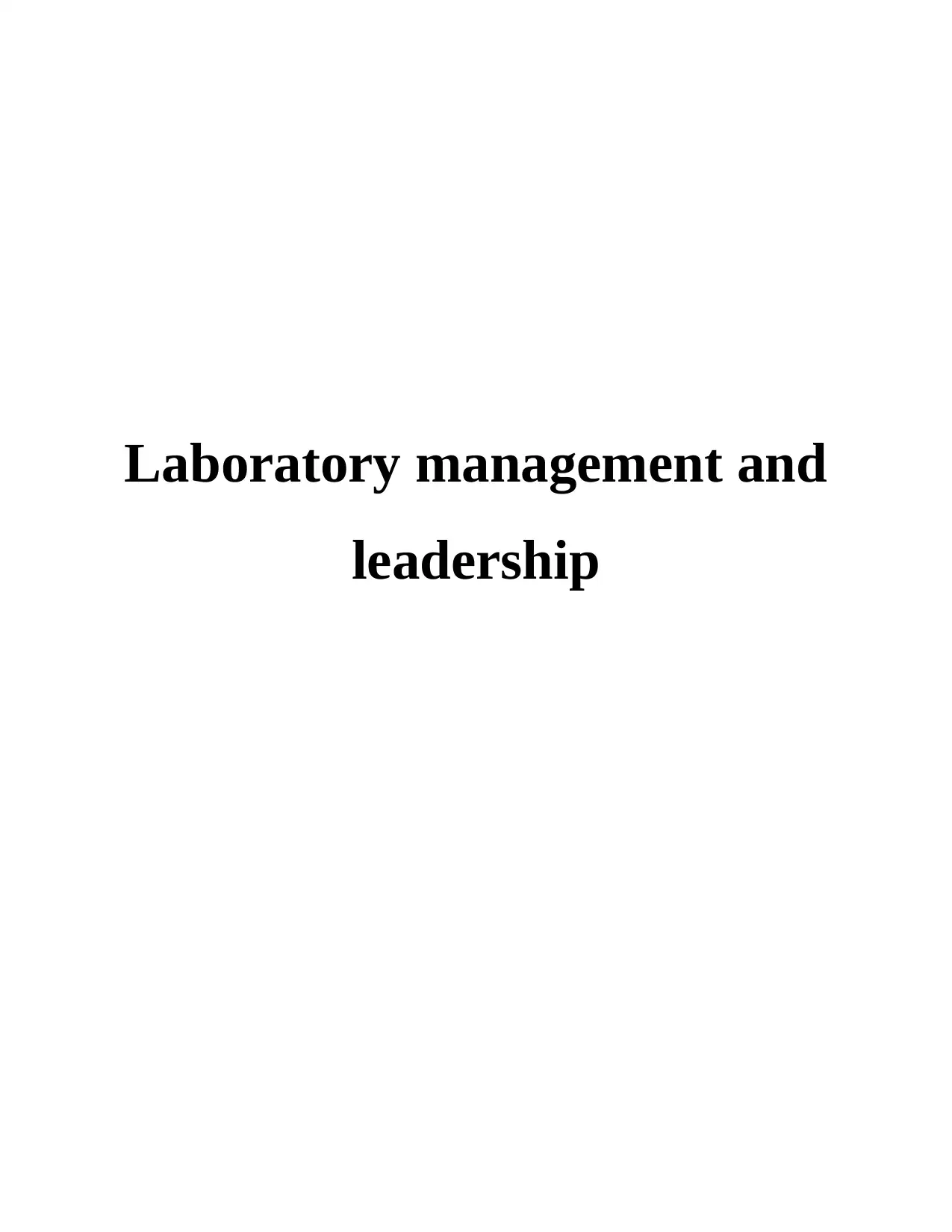
Laboratory management and
leadership
leadership
Paraphrase This Document
Need a fresh take? Get an instant paraphrase of this document with our AI Paraphraser

TABLE OF CONTENTS
ESSAY.............................................................................................................................................1
Main body........................................................................................................................................1
REFERENCES................................................................................................................................6
ESSAY.............................................................................................................................................1
Main body........................................................................................................................................1
REFERENCES................................................................................................................................6
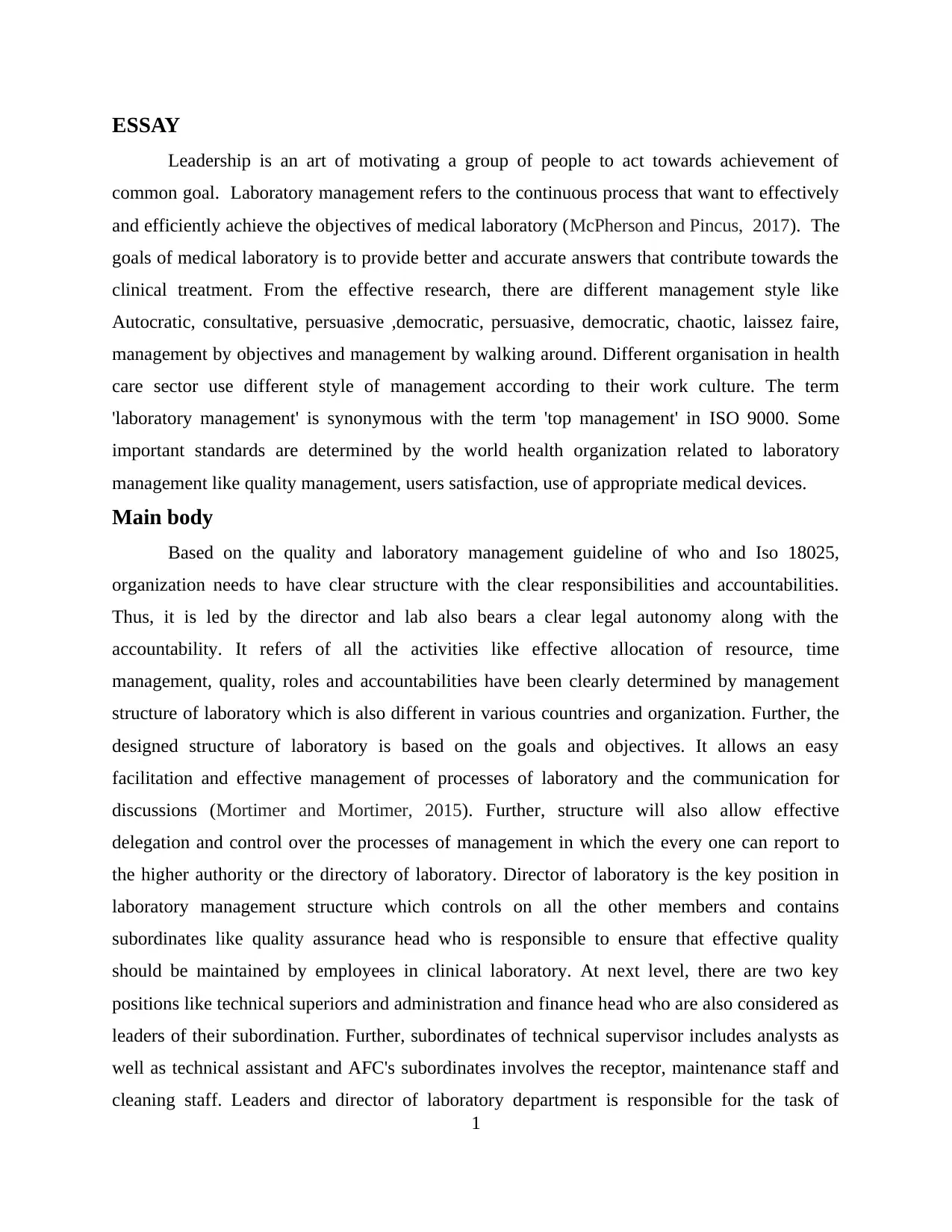
ESSAY
Leadership is an art of motivating a group of people to act towards achievement of
common goal. Laboratory management refers to the continuous process that want to effectively
and efficiently achieve the objectives of medical laboratory (McPherson and Pincus, 2017). The
goals of medical laboratory is to provide better and accurate answers that contribute towards the
clinical treatment. From the effective research, there are different management style like
Autocratic, consultative, persuasive ,democratic, persuasive, democratic, chaotic, laissez faire,
management by objectives and management by walking around. Different organisation in health
care sector use different style of management according to their work culture. The term
'laboratory management' is synonymous with the term 'top management' in ISO 9000. Some
important standards are determined by the world health organization related to laboratory
management like quality management, users satisfaction, use of appropriate medical devices.
Main body
Based on the quality and laboratory management guideline of who and Iso 18025,
organization needs to have clear structure with the clear responsibilities and accountabilities.
Thus, it is led by the director and lab also bears a clear legal autonomy along with the
accountability. It refers of all the activities like effective allocation of resource, time
management, quality, roles and accountabilities have been clearly determined by management
structure of laboratory which is also different in various countries and organization. Further, the
designed structure of laboratory is based on the goals and objectives. It allows an easy
facilitation and effective management of processes of laboratory and the communication for
discussions (Mortimer and Mortimer, 2015). Further, structure will also allow effective
delegation and control over the processes of management in which the every one can report to
the higher authority or the directory of laboratory. Director of laboratory is the key position in
laboratory management structure which controls on all the other members and contains
subordinates like quality assurance head who is responsible to ensure that effective quality
should be maintained by employees in clinical laboratory. At next level, there are two key
positions like technical superiors and administration and finance head who are also considered as
leaders of their subordination. Further, subordinates of technical supervisor includes analysts as
well as technical assistant and AFC's subordinates involves the receptor, maintenance staff and
cleaning staff. Leaders and director of laboratory department is responsible for the task of
1
Leadership is an art of motivating a group of people to act towards achievement of
common goal. Laboratory management refers to the continuous process that want to effectively
and efficiently achieve the objectives of medical laboratory (McPherson and Pincus, 2017). The
goals of medical laboratory is to provide better and accurate answers that contribute towards the
clinical treatment. From the effective research, there are different management style like
Autocratic, consultative, persuasive ,democratic, persuasive, democratic, chaotic, laissez faire,
management by objectives and management by walking around. Different organisation in health
care sector use different style of management according to their work culture. The term
'laboratory management' is synonymous with the term 'top management' in ISO 9000. Some
important standards are determined by the world health organization related to laboratory
management like quality management, users satisfaction, use of appropriate medical devices.
Main body
Based on the quality and laboratory management guideline of who and Iso 18025,
organization needs to have clear structure with the clear responsibilities and accountabilities.
Thus, it is led by the director and lab also bears a clear legal autonomy along with the
accountability. It refers of all the activities like effective allocation of resource, time
management, quality, roles and accountabilities have been clearly determined by management
structure of laboratory which is also different in various countries and organization. Further, the
designed structure of laboratory is based on the goals and objectives. It allows an easy
facilitation and effective management of processes of laboratory and the communication for
discussions (Mortimer and Mortimer, 2015). Further, structure will also allow effective
delegation and control over the processes of management in which the every one can report to
the higher authority or the directory of laboratory. Director of laboratory is the key position in
laboratory management structure which controls on all the other members and contains
subordinates like quality assurance head who is responsible to ensure that effective quality
should be maintained by employees in clinical laboratory. At next level, there are two key
positions like technical superiors and administration and finance head who are also considered as
leaders of their subordination. Further, subordinates of technical supervisor includes analysts as
well as technical assistant and AFC's subordinates involves the receptor, maintenance staff and
cleaning staff. Leaders and director of laboratory department is responsible for the task of
1
⊘ This is a preview!⊘
Do you want full access?
Subscribe today to unlock all pages.

Trusted by 1+ million students worldwide
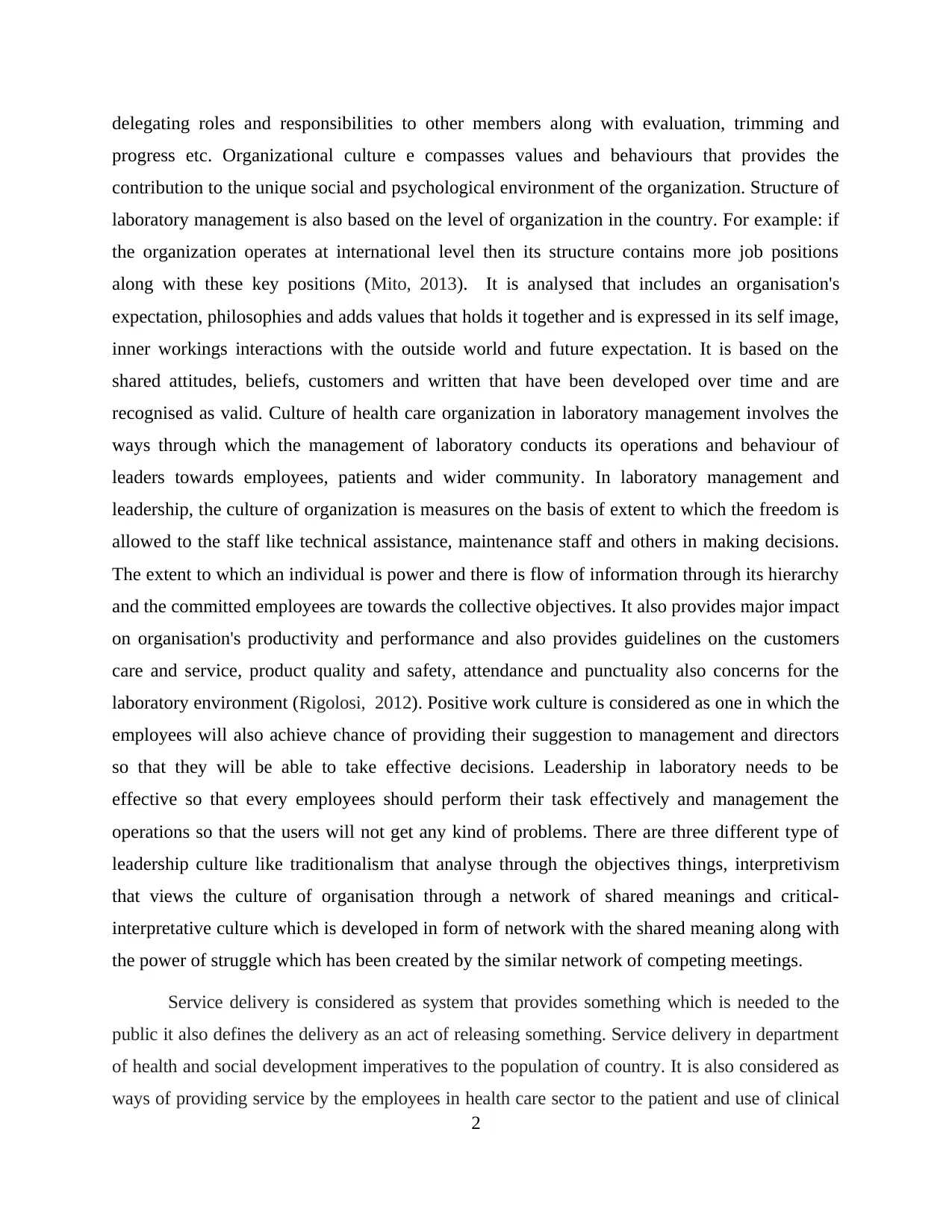
delegating roles and responsibilities to other members along with evaluation, trimming and
progress etc. Organizational culture e compasses values and behaviours that provides the
contribution to the unique social and psychological environment of the organization. Structure of
laboratory management is also based on the level of organization in the country. For example: if
the organization operates at international level then its structure contains more job positions
along with these key positions (Mito, 2013). It is analysed that includes an organisation's
expectation, philosophies and adds values that holds it together and is expressed in its self image,
inner workings interactions with the outside world and future expectation. It is based on the
shared attitudes, beliefs, customers and written that have been developed over time and are
recognised as valid. Culture of health care organization in laboratory management involves the
ways through which the management of laboratory conducts its operations and behaviour of
leaders towards employees, patients and wider community. In laboratory management and
leadership, the culture of organization is measures on the basis of extent to which the freedom is
allowed to the staff like technical assistance, maintenance staff and others in making decisions.
The extent to which an individual is power and there is flow of information through its hierarchy
and the committed employees are towards the collective objectives. It also provides major impact
on organisation's productivity and performance and also provides guidelines on the customers
care and service, product quality and safety, attendance and punctuality also concerns for the
laboratory environment (Rigolosi, 2012). Positive work culture is considered as one in which the
employees will also achieve chance of providing their suggestion to management and directors
so that they will be able to take effective decisions. Leadership in laboratory needs to be
effective so that every employees should perform their task effectively and management the
operations so that the users will not get any kind of problems. There are three different type of
leadership culture like traditionalism that analyse through the objectives things, interpretivism
that views the culture of organisation through a network of shared meanings and critical-
interpretative culture which is developed in form of network with the shared meaning along with
the power of struggle which has been created by the similar network of competing meetings.
Service delivery is considered as system that provides something which is needed to the
public it also defines the delivery as an act of releasing something. Service delivery in department
of health and social development imperatives to the population of country. It is also considered as
ways of providing service by the employees in health care sector to the patient and use of clinical
2
progress etc. Organizational culture e compasses values and behaviours that provides the
contribution to the unique social and psychological environment of the organization. Structure of
laboratory management is also based on the level of organization in the country. For example: if
the organization operates at international level then its structure contains more job positions
along with these key positions (Mito, 2013). It is analysed that includes an organisation's
expectation, philosophies and adds values that holds it together and is expressed in its self image,
inner workings interactions with the outside world and future expectation. It is based on the
shared attitudes, beliefs, customers and written that have been developed over time and are
recognised as valid. Culture of health care organization in laboratory management involves the
ways through which the management of laboratory conducts its operations and behaviour of
leaders towards employees, patients and wider community. In laboratory management and
leadership, the culture of organization is measures on the basis of extent to which the freedom is
allowed to the staff like technical assistance, maintenance staff and others in making decisions.
The extent to which an individual is power and there is flow of information through its hierarchy
and the committed employees are towards the collective objectives. It also provides major impact
on organisation's productivity and performance and also provides guidelines on the customers
care and service, product quality and safety, attendance and punctuality also concerns for the
laboratory environment (Rigolosi, 2012). Positive work culture is considered as one in which the
employees will also achieve chance of providing their suggestion to management and directors
so that they will be able to take effective decisions. Leadership in laboratory needs to be
effective so that every employees should perform their task effectively and management the
operations so that the users will not get any kind of problems. There are three different type of
leadership culture like traditionalism that analyse through the objectives things, interpretivism
that views the culture of organisation through a network of shared meanings and critical-
interpretative culture which is developed in form of network with the shared meaning along with
the power of struggle which has been created by the similar network of competing meetings.
Service delivery is considered as system that provides something which is needed to the
public it also defines the delivery as an act of releasing something. Service delivery in department
of health and social development imperatives to the population of country. It is also considered as
ways of providing service by the employees in health care sector to the patient and use of clinical
2
Paraphrase This Document
Need a fresh take? Get an instant paraphrase of this document with our AI Paraphraser
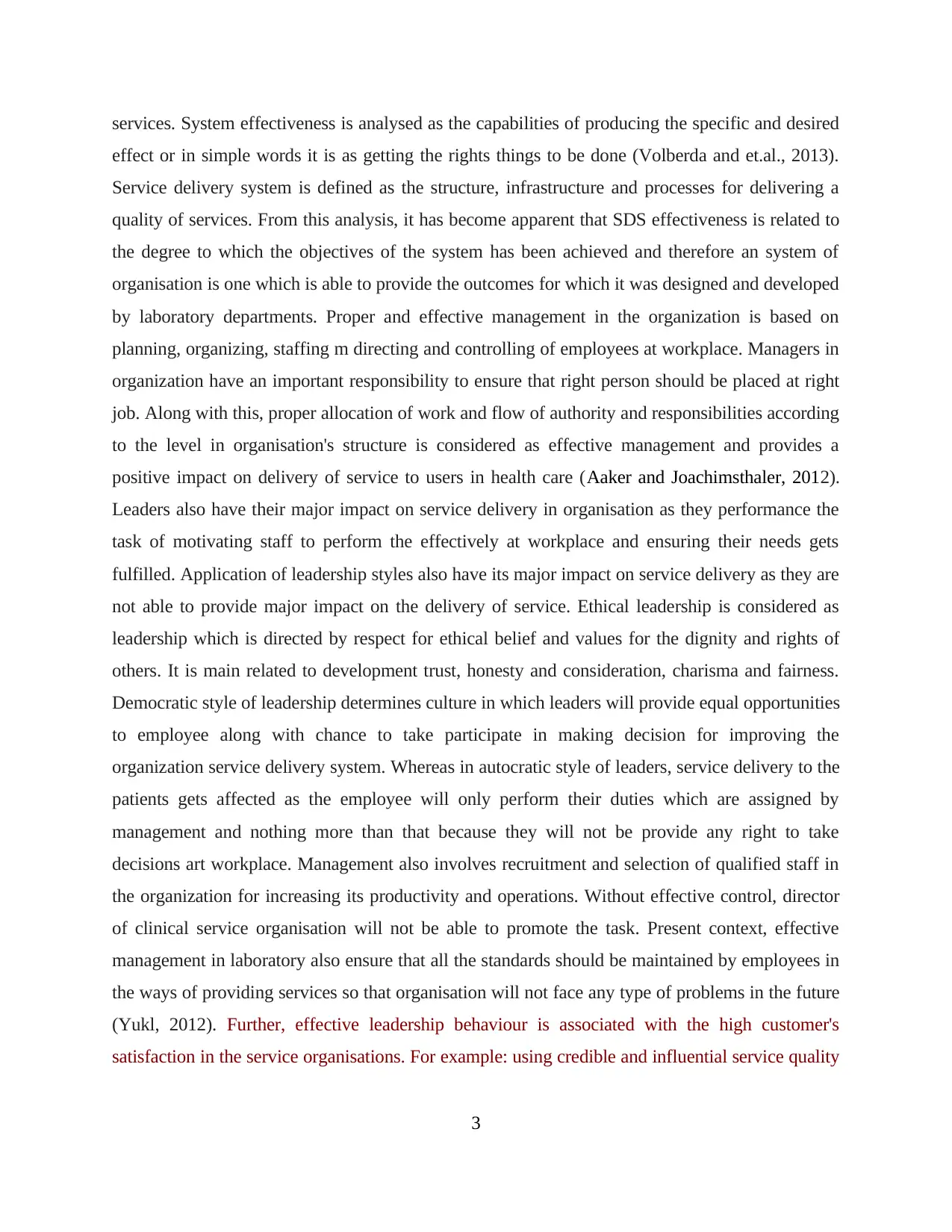
services. System effectiveness is analysed as the capabilities of producing the specific and desired
effect or in simple words it is as getting the rights things to be done (Volberda and et.al., 2013).
Service delivery system is defined as the structure, infrastructure and processes for delivering a
quality of services. From this analysis, it has become apparent that SDS effectiveness is related to
the degree to which the objectives of the system has been achieved and therefore an system of
organisation is one which is able to provide the outcomes for which it was designed and developed
by laboratory departments. Proper and effective management in the organization is based on
planning, organizing, staffing m directing and controlling of employees at workplace. Managers in
organization have an important responsibility to ensure that right person should be placed at right
job. Along with this, proper allocation of work and flow of authority and responsibilities according
to the level in organisation's structure is considered as effective management and provides a
positive impact on delivery of service to users in health care (Aaker and Joachimsthaler, 2012).
Leaders also have their major impact on service delivery in organisation as they performance the
task of motivating staff to perform the effectively at workplace and ensuring their needs gets
fulfilled. Application of leadership styles also have its major impact on service delivery as they are
not able to provide major impact on the delivery of service. Ethical leadership is considered as
leadership which is directed by respect for ethical belief and values for the dignity and rights of
others. It is main related to development trust, honesty and consideration, charisma and fairness.
Democratic style of leadership determines culture in which leaders will provide equal opportunities
to employee along with chance to take participate in making decision for improving the
organization service delivery system. Whereas in autocratic style of leaders, service delivery to the
patients gets affected as the employee will only perform their duties which are assigned by
management and nothing more than that because they will not be provide any right to take
decisions art workplace. Management also involves recruitment and selection of qualified staff in
the organization for increasing its productivity and operations. Without effective control, director
of clinical service organisation will not be able to promote the task. Present context, effective
management in laboratory also ensure that all the standards should be maintained by employees in
the ways of providing services so that organisation will not face any type of problems in the future
(Yukl, 2012). Further, effective leadership behaviour is associated with the high customer's
satisfaction in the service organisations. For example: using credible and influential service quality
3
effect or in simple words it is as getting the rights things to be done (Volberda and et.al., 2013).
Service delivery system is defined as the structure, infrastructure and processes for delivering a
quality of services. From this analysis, it has become apparent that SDS effectiveness is related to
the degree to which the objectives of the system has been achieved and therefore an system of
organisation is one which is able to provide the outcomes for which it was designed and developed
by laboratory departments. Proper and effective management in the organization is based on
planning, organizing, staffing m directing and controlling of employees at workplace. Managers in
organization have an important responsibility to ensure that right person should be placed at right
job. Along with this, proper allocation of work and flow of authority and responsibilities according
to the level in organisation's structure is considered as effective management and provides a
positive impact on delivery of service to users in health care (Aaker and Joachimsthaler, 2012).
Leaders also have their major impact on service delivery in organisation as they performance the
task of motivating staff to perform the effectively at workplace and ensuring their needs gets
fulfilled. Application of leadership styles also have its major impact on service delivery as they are
not able to provide major impact on the delivery of service. Ethical leadership is considered as
leadership which is directed by respect for ethical belief and values for the dignity and rights of
others. It is main related to development trust, honesty and consideration, charisma and fairness.
Democratic style of leadership determines culture in which leaders will provide equal opportunities
to employee along with chance to take participate in making decision for improving the
organization service delivery system. Whereas in autocratic style of leaders, service delivery to the
patients gets affected as the employee will only perform their duties which are assigned by
management and nothing more than that because they will not be provide any right to take
decisions art workplace. Management also involves recruitment and selection of qualified staff in
the organization for increasing its productivity and operations. Without effective control, director
of clinical service organisation will not be able to promote the task. Present context, effective
management in laboratory also ensure that all the standards should be maintained by employees in
the ways of providing services so that organisation will not face any type of problems in the future
(Yukl, 2012). Further, effective leadership behaviour is associated with the high customer's
satisfaction in the service organisations. For example: using credible and influential service quality
3
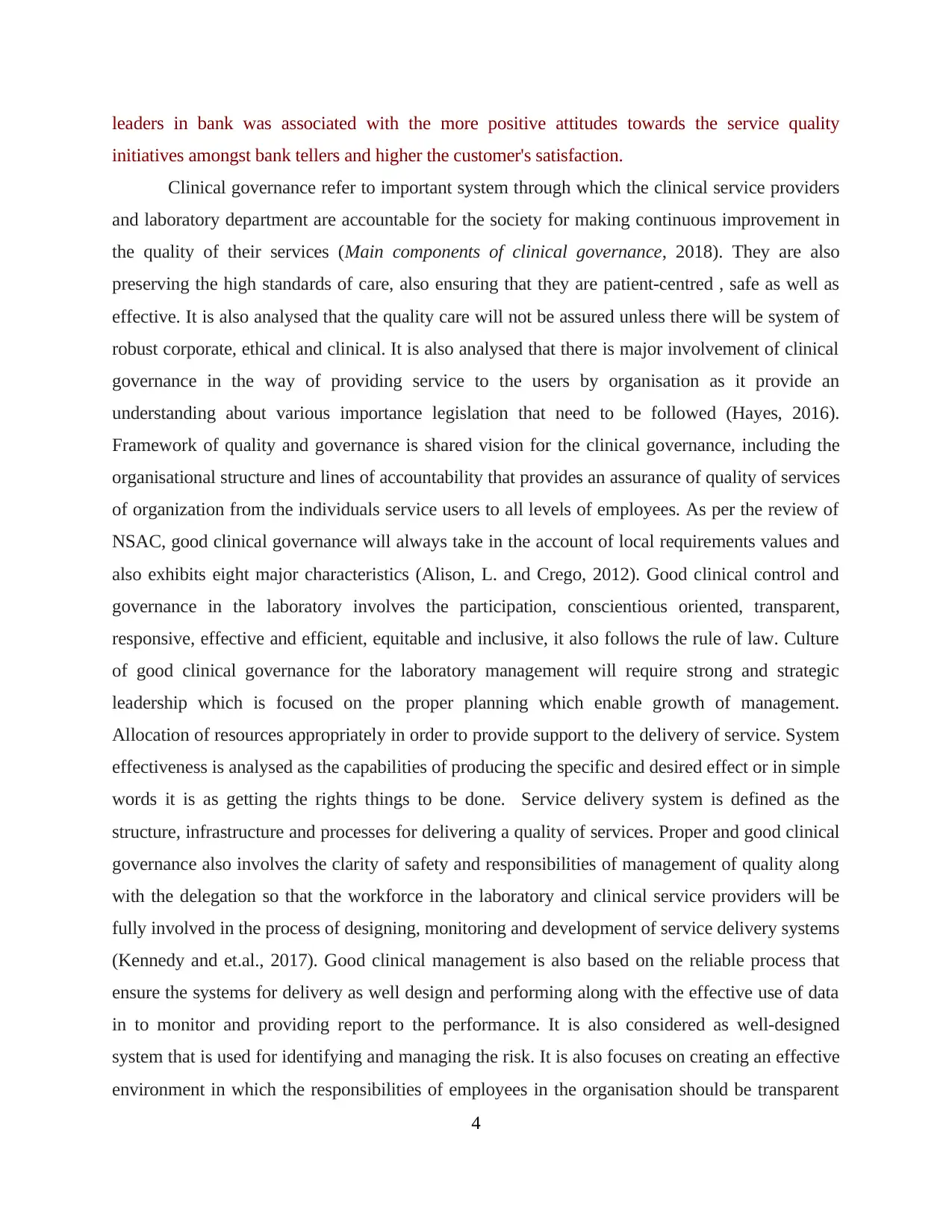
leaders in bank was associated with the more positive attitudes towards the service quality
initiatives amongst bank tellers and higher the customer's satisfaction.
Clinical governance refer to important system through which the clinical service providers
and laboratory department are accountable for the society for making continuous improvement in
the quality of their services (Main components of clinical governance, 2018). They are also
preserving the high standards of care, also ensuring that they are patient-centred , safe as well as
effective. It is also analysed that the quality care will not be assured unless there will be system of
robust corporate, ethical and clinical. It is also analysed that there is major involvement of clinical
governance in the way of providing service to the users by organisation as it provide an
understanding about various importance legislation that need to be followed (Hayes, 2016).
Framework of quality and governance is shared vision for the clinical governance, including the
organisational structure and lines of accountability that provides an assurance of quality of services
of organization from the individuals service users to all levels of employees. As per the review of
NSAC, good clinical governance will always take in the account of local requirements values and
also exhibits eight major characteristics (Alison, L. and Crego, 2012). Good clinical control and
governance in the laboratory involves the participation, conscientious oriented, transparent,
responsive, effective and efficient, equitable and inclusive, it also follows the rule of law. Culture
of good clinical governance for the laboratory management will require strong and strategic
leadership which is focused on the proper planning which enable growth of management.
Allocation of resources appropriately in order to provide support to the delivery of service. System
effectiveness is analysed as the capabilities of producing the specific and desired effect or in simple
words it is as getting the rights things to be done. Service delivery system is defined as the
structure, infrastructure and processes for delivering a quality of services. Proper and good clinical
governance also involves the clarity of safety and responsibilities of management of quality along
with the delegation so that the workforce in the laboratory and clinical service providers will be
fully involved in the process of designing, monitoring and development of service delivery systems
(Kennedy and et.al., 2017). Good clinical management is also based on the reliable process that
ensure the systems for delivery as well design and performing along with the effective use of data
in to monitor and providing report to the performance. It is also considered as well-designed
system that is used for identifying and managing the risk. It is also focuses on creating an effective
environment in which the responsibilities of employees in the organisation should be transparent
4
initiatives amongst bank tellers and higher the customer's satisfaction.
Clinical governance refer to important system through which the clinical service providers
and laboratory department are accountable for the society for making continuous improvement in
the quality of their services (Main components of clinical governance, 2018). They are also
preserving the high standards of care, also ensuring that they are patient-centred , safe as well as
effective. It is also analysed that the quality care will not be assured unless there will be system of
robust corporate, ethical and clinical. It is also analysed that there is major involvement of clinical
governance in the way of providing service to the users by organisation as it provide an
understanding about various importance legislation that need to be followed (Hayes, 2016).
Framework of quality and governance is shared vision for the clinical governance, including the
organisational structure and lines of accountability that provides an assurance of quality of services
of organization from the individuals service users to all levels of employees. As per the review of
NSAC, good clinical governance will always take in the account of local requirements values and
also exhibits eight major characteristics (Alison, L. and Crego, 2012). Good clinical control and
governance in the laboratory involves the participation, conscientious oriented, transparent,
responsive, effective and efficient, equitable and inclusive, it also follows the rule of law. Culture
of good clinical governance for the laboratory management will require strong and strategic
leadership which is focused on the proper planning which enable growth of management.
Allocation of resources appropriately in order to provide support to the delivery of service. System
effectiveness is analysed as the capabilities of producing the specific and desired effect or in simple
words it is as getting the rights things to be done. Service delivery system is defined as the
structure, infrastructure and processes for delivering a quality of services. Proper and good clinical
governance also involves the clarity of safety and responsibilities of management of quality along
with the delegation so that the workforce in the laboratory and clinical service providers will be
fully involved in the process of designing, monitoring and development of service delivery systems
(Kennedy and et.al., 2017). Good clinical management is also based on the reliable process that
ensure the systems for delivery as well design and performing along with the effective use of data
in to monitor and providing report to the performance. It is also considered as well-designed
system that is used for identifying and managing the risk. It is also focuses on creating an effective
environment in which the responsibilities of employees in the organisation should be transparent
4
⊘ This is a preview!⊘
Do you want full access?
Subscribe today to unlock all pages.

Trusted by 1+ million students worldwide
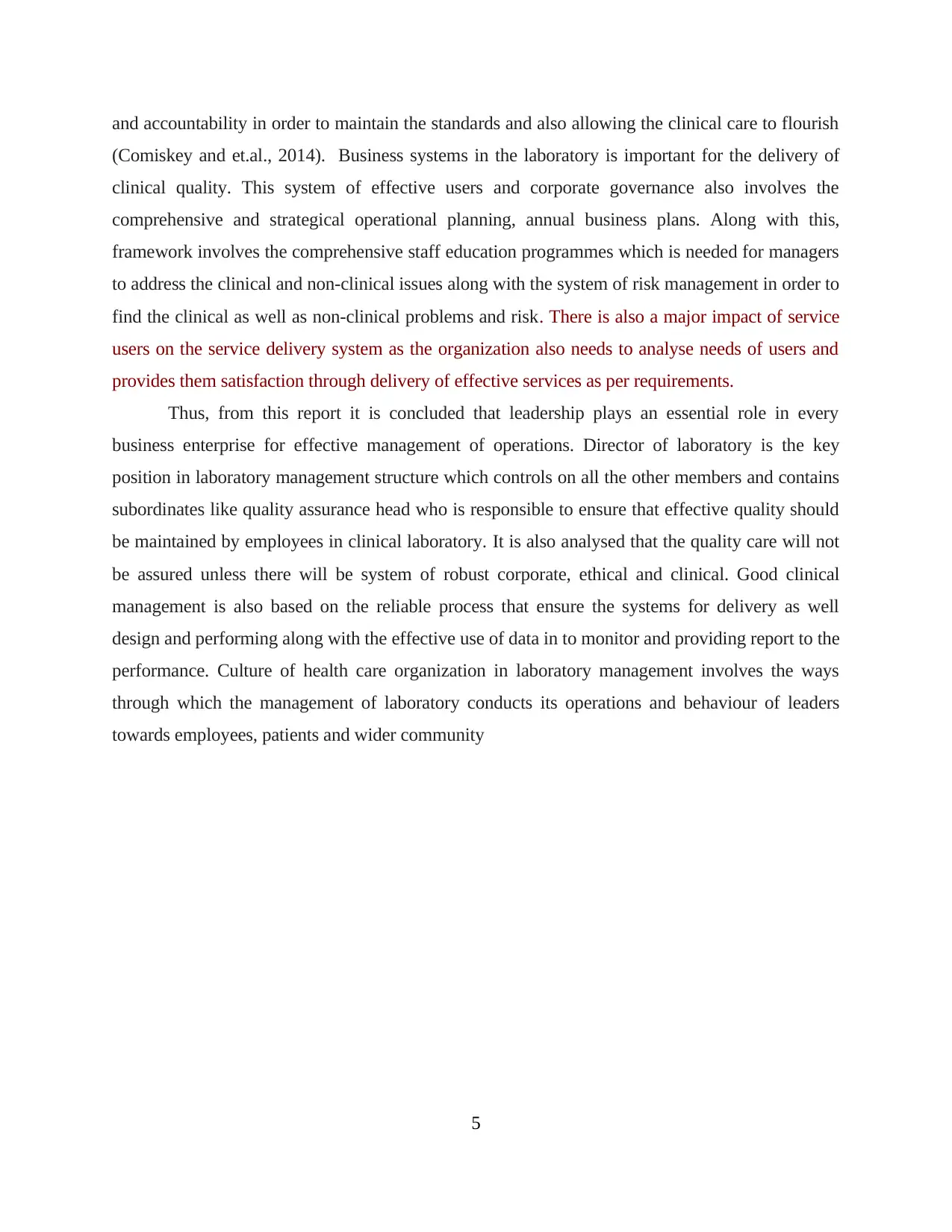
and accountability in order to maintain the standards and also allowing the clinical care to flourish
(Comiskey and et.al., 2014). Business systems in the laboratory is important for the delivery of
clinical quality. This system of effective users and corporate governance also involves the
comprehensive and strategical operational planning, annual business plans. Along with this,
framework involves the comprehensive staff education programmes which is needed for managers
to address the clinical and non-clinical issues along with the system of risk management in order to
find the clinical as well as non-clinical problems and risk. There is also a major impact of service
users on the service delivery system as the organization also needs to analyse needs of users and
provides them satisfaction through delivery of effective services as per requirements.
Thus, from this report it is concluded that leadership plays an essential role in every
business enterprise for effective management of operations. Director of laboratory is the key
position in laboratory management structure which controls on all the other members and contains
subordinates like quality assurance head who is responsible to ensure that effective quality should
be maintained by employees in clinical laboratory. It is also analysed that the quality care will not
be assured unless there will be system of robust corporate, ethical and clinical. Good clinical
management is also based on the reliable process that ensure the systems for delivery as well
design and performing along with the effective use of data in to monitor and providing report to the
performance. Culture of health care organization in laboratory management involves the ways
through which the management of laboratory conducts its operations and behaviour of leaders
towards employees, patients and wider community
5
(Comiskey and et.al., 2014). Business systems in the laboratory is important for the delivery of
clinical quality. This system of effective users and corporate governance also involves the
comprehensive and strategical operational planning, annual business plans. Along with this,
framework involves the comprehensive staff education programmes which is needed for managers
to address the clinical and non-clinical issues along with the system of risk management in order to
find the clinical as well as non-clinical problems and risk. There is also a major impact of service
users on the service delivery system as the organization also needs to analyse needs of users and
provides them satisfaction through delivery of effective services as per requirements.
Thus, from this report it is concluded that leadership plays an essential role in every
business enterprise for effective management of operations. Director of laboratory is the key
position in laboratory management structure which controls on all the other members and contains
subordinates like quality assurance head who is responsible to ensure that effective quality should
be maintained by employees in clinical laboratory. It is also analysed that the quality care will not
be assured unless there will be system of robust corporate, ethical and clinical. Good clinical
management is also based on the reliable process that ensure the systems for delivery as well
design and performing along with the effective use of data in to monitor and providing report to the
performance. Culture of health care organization in laboratory management involves the ways
through which the management of laboratory conducts its operations and behaviour of leaders
towards employees, patients and wider community
5
Paraphrase This Document
Need a fresh take? Get an instant paraphrase of this document with our AI Paraphraser
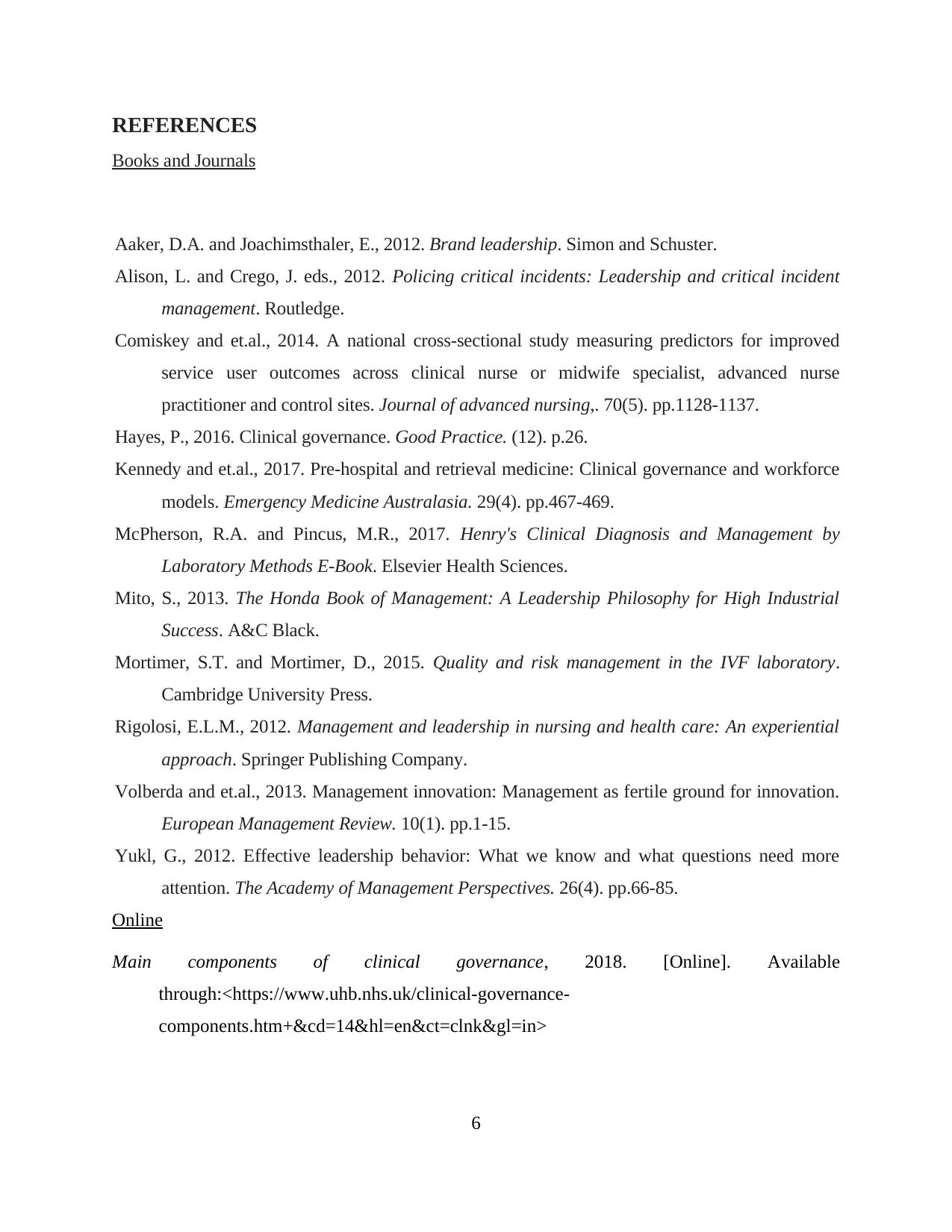
REFERENCES
Books and Journals
Aaker, D.A. and Joachimsthaler, E., 2012. Brand leadership. Simon and Schuster.
Alison, L. and Crego, J. eds., 2012. Policing critical incidents: Leadership and critical incident
management. Routledge.
Comiskey and et.al., 2014. A national cross‐sectional study measuring predictors for improved
service user outcomes across clinical nurse or midwife specialist, advanced nurse
practitioner and control sites. Journal of advanced nursing,. 70(5). pp.1128-1137.
Hayes, P., 2016. Clinical governance. Good Practice. (12). p.26.
Kennedy and et.al., 2017. Pre‐hospital and retrieval medicine: Clinical governance and workforce
models. Emergency Medicine Australasia. 29(4). pp.467-469.
McPherson, R.A. and Pincus, M.R., 2017. Henry's Clinical Diagnosis and Management by
Laboratory Methods E-Book. Elsevier Health Sciences.
Mito, S., 2013. The Honda Book of Management: A Leadership Philosophy for High Industrial
Success. A&C Black.
Mortimer, S.T. and Mortimer, D., 2015. Quality and risk management in the IVF laboratory.
Cambridge University Press.
Rigolosi, E.L.M., 2012. Management and leadership in nursing and health care: An experiential
approach. Springer Publishing Company.
Volberda and et.al., 2013. Management innovation: Management as fertile ground for innovation.
European Management Review. 10(1). pp.1-15.
Yukl, G., 2012. Effective leadership behavior: What we know and what questions need more
attention. The Academy of Management Perspectives. 26(4). pp.66-85.
Online
Main components of clinical governance, 2018. [Online]. Available
through:<https://www.uhb.nhs.uk/clinical-governance-
components.htm+&cd=14&hl=en&ct=clnk&gl=in>
6
Books and Journals
Aaker, D.A. and Joachimsthaler, E., 2012. Brand leadership. Simon and Schuster.
Alison, L. and Crego, J. eds., 2012. Policing critical incidents: Leadership and critical incident
management. Routledge.
Comiskey and et.al., 2014. A national cross‐sectional study measuring predictors for improved
service user outcomes across clinical nurse or midwife specialist, advanced nurse
practitioner and control sites. Journal of advanced nursing,. 70(5). pp.1128-1137.
Hayes, P., 2016. Clinical governance. Good Practice. (12). p.26.
Kennedy and et.al., 2017. Pre‐hospital and retrieval medicine: Clinical governance and workforce
models. Emergency Medicine Australasia. 29(4). pp.467-469.
McPherson, R.A. and Pincus, M.R., 2017. Henry's Clinical Diagnosis and Management by
Laboratory Methods E-Book. Elsevier Health Sciences.
Mito, S., 2013. The Honda Book of Management: A Leadership Philosophy for High Industrial
Success. A&C Black.
Mortimer, S.T. and Mortimer, D., 2015. Quality and risk management in the IVF laboratory.
Cambridge University Press.
Rigolosi, E.L.M., 2012. Management and leadership in nursing and health care: An experiential
approach. Springer Publishing Company.
Volberda and et.al., 2013. Management innovation: Management as fertile ground for innovation.
European Management Review. 10(1). pp.1-15.
Yukl, G., 2012. Effective leadership behavior: What we know and what questions need more
attention. The Academy of Management Perspectives. 26(4). pp.66-85.
Online
Main components of clinical governance, 2018. [Online]. Available
through:<https://www.uhb.nhs.uk/clinical-governance-
components.htm+&cd=14&hl=en&ct=clnk&gl=in>
6
1 out of 8
Related Documents
Your All-in-One AI-Powered Toolkit for Academic Success.
+13062052269
info@desklib.com
Available 24*7 on WhatsApp / Email
![[object Object]](/_next/static/media/star-bottom.7253800d.svg)
Unlock your academic potential
Copyright © 2020–2025 A2Z Services. All Rights Reserved. Developed and managed by ZUCOL.





